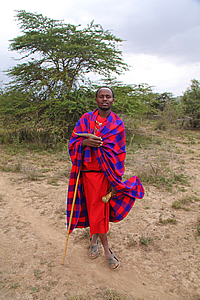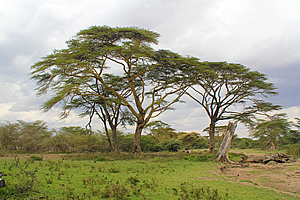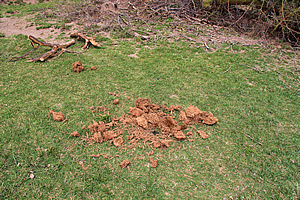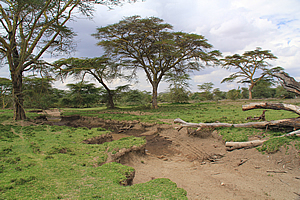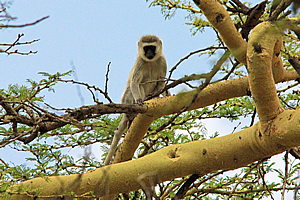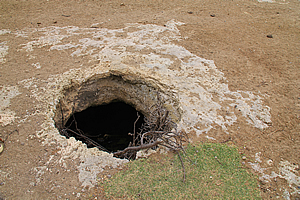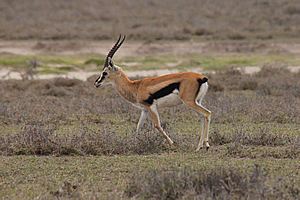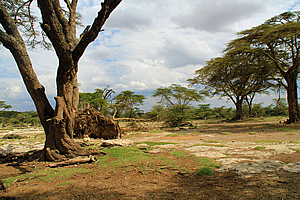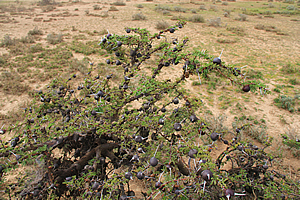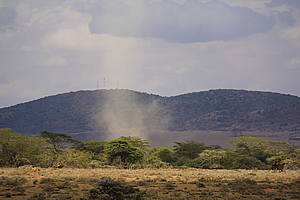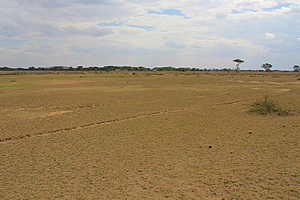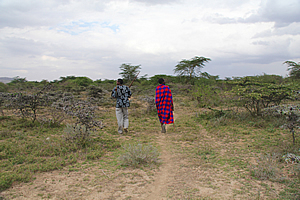--- Archive files ---
Home > Travels > Masai Mara > 4 |
Masai Warrior with a Mobile Phone
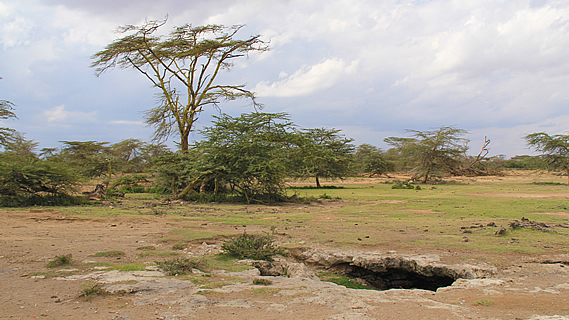
AFTER eating the huge lunch at the ecolodge, the Masai warriors Luke and Samuel took me on a nature walk around the local reserve. Luke wore a very brightly coloured red and brown cloak – known in Masai circles as a khanga. Although he looked great, it seemed to me to be totally inappropriate for a hunter to be wearing such brightly coloured clothing. It would be better to be wearing army camouflage or at least clothes that blended in with the natural landscape. He mentioned confidently that humans were the king of the forest and all animals run away from us. That was understandable with him being so brightly coloured.
Luke the Masai warrior |
Luke went further to mention that the Masai were the fittest of all humans, walking one hundred kilometres per day. That sounded a bit excessive by my calculation, but so be it. I did believe they would be able to walk very long distances with their very long limbs and athletic stature. This is not to mention the need to walk around the plains to hunt and care for their livestock. He carried a large knife and a spear, whilst Samuel carried a crude bow and arrow. I was carrying my camera with the telephoto lens attached. In the African savannah walking amongst these Masai warriors it looked totally out of place here like a high tech rocket launcher. I felt like a soldier walking with them, but wondered if between us we were armed well enough to deal with any predators that could be prowling in the area. After all we were right in the middle of lion territory.
The sad reality was that we were in the open. Although we were not quite in Masai Mara, the animals didn’t know that, and they were free to roam wherever they wanted. There are lions, leopards, cheetahs, hyenas, and goodness knows what other carnivores out there waiting to pounce on us. Even some of the herbivores like elephants and hippos were lethal. They were all out there. I didn’t share Luke or Samuel’s confidence that we were safe with only a knife, a spear, a bow and arrow, a giant camera, and a brightly coloured Masai cloak between us.
Acacia trees |
Luke then announced that a Masai boy becomes a man when he kills a lion, using only a knife and spear. That was somewhat encouraging, I was about to ask him if he was a man yet, when he changed the topic. He went on to describe their diet, and how there are three components to it; the blood, the milk, and the meat. They drink the blood to give them life, drink the milk to quench their thirst, and eat the meat to give them energy. Tough luck if you’re vegetarian I thought.
Elephant poo |
They showed me some elephant droppings. I could clearly see the fibrous vegetation that hadn’t decomposed very well in their digestive systems. Luke explained to me that the elephants eat all sorts of vegetation, containing all sorts of nutrients. Therefore the Masai eat the elephant dropping. I didn’t really understand that logic. I’m inclined to just eat the plants, not the animal droppings. Fortunately they didn’t offer me any of the elephant droppings to try eating, but if they had, I would have turned it down. I have never turned down exotic food before, but decided there and then that there is a line to be drawn here. It’s one thing eating deep fried spiders or snake meat in Cambodia, but this was just too exotic for me no matter how convincingly nutritious they told me it was. Luke picked some of it up and started extracting pieces from it. I hoped he will wash his hands before next handling food back at the hut.
Dry riverbed |
At this point I found myself surrounded by a lot of acacia trees. These grew along the banks of a stream. It would have been a stream if there had been any water in it. This was a clear sign it was the dry season here. The channel had been well worn a good metre into the surface of the earth indicating a loft of water would flow here during the rainy season. Luke explained these streams are completely dry throughout the dry season.
Monkey in the tree |
Then he pointed up one of the nearby trees. There was a group of small monkeys sitting in the tree, some moving around in the branches. Then I saw a couple scurrying along the ground through the thick green grass. They were timid creatures, not doubt scared of Luke’s brightly coloured clothes.
Samuel and Luke led me along a trail above the stream bed. We passed a couple of large trees that had been knocked down. I initially thought they had fallen in some huge storm that had swept through the area in recent years, but Luke said this had been caused by elephants. Gosh, those trees were a hundred times stronger than my tent or even the main the hut, or the flimsy fence that surrounded the eco lodge. If an elephant could knock over a huge tree like this, they could easily annihilate the camp.
Salt lick |
From here we left the stream and walked back into a dry area. The ground here was quite barren and dusty, surrounded by more trees that had been knocked down by elephants.
We arrived at a number of what appeared to be sink holes in the ground. Then I saw they were set in pure salt. These salt beds indicated a substantial lake had been there at some stage. There were a few holes in the salt, each filled with water to about a metre below the ground. Luke explained the Masai drink the water during the dry season as do the elephants. He told me it was pure and I should have a go. I tried the water but it was a bit too salty for me as expected, but the locals were used to it. It was their water supply.
Gazelle |
We walked further along the narrow trail into scrubby grassland. There were a few gazelles scattered in amongst the grass, but fortunately no predators. As I looked around to reassure myself there were no lions hiding in the grass, I could see another large dust devil whirling about a kilometre away, adding to the light haze under the now overcast sky.
Then a mobile phone started ringing.
In Western society nobody thinks anything of mobile phones. Here in the middle of the remote African wilderness having a mobile phone seemed like a ridiculous idea. Luke put his hand into his brightly coloured cloak and produced a mobile phone. Suddenly he transformed from the mighty warrior walking me through the lion invested savannah into just another regular guy with a phone. It was most odd.
Tree knocked over by elephants |
For a few moments Luke spoke in Swahili, the local language. Perhaps someone was checking that we were still alive, or maybe he was being briefed on the next part of the tour.
The call only lasted a minute, and once finished he put the phone back into the pocket of his brightly coloured cloak. Now we were back to Masai normality, transported in time hundreds of thousands of years into the distant past to exploring how the earliest humans, our most distant ancestors, lived.
Ant stunted acacia |
Luke showed me different types of acacia tree growing here. One particularly interesting one was very stunted, no more than a small shrub. There were small hollow balls of wood growing around the thorns. At first I thought they were nuts – perhaps they were. They were filled with ants though. A small species of ant lives in these balls knowing the thorns protect them from predators. It’s not quite the ideal win-win symbiotic circle though with the ants eating out the inside of the tree. This causes the tree to be seriously stunted into a small thorny scrubby bush that only grows two metres tall whilst their related species quickly grow tall to tower above the large ground dwelling herbivores.
Dust devil |
There were numerous scrubby trees that we passed through. Most of these were covered in thorns or were very bitter to the taste making it a challenge for animals to eat.
By now Luke thought I would be completely lost and totally dependent on him and Samuel to get me back to the camp. After all I am just a tourist from a large city on the other side of the planet. What would I know about navigating my way around the Masai Plains? He had claimed earlier that the Masai people walk a hundred kilometres per day. That sounded like too much unless they were running most of it. He said they have an excellent sense of navigation and he knew exactly where he was.
Across the plain to the eco lodge |
He asked me if I had any idea where the eco camp was. I quickly looked to the left and upon seeing the faint outlines of the tents in amongst the acacia trees about a kilometre away I told him the camp was over there. Luke was very impressed. He said most tourists he takes out here have no idea about how where they are. By this point they are totally dependent on the guides to lead them through the barren grasslands.
I don’t know why I have such a good sense of navigation. Perhaps I have a built in compass that I haven’t quite tapped into yet. Perhaps I’m just observant.
Luke and Samuel |
I recalled a time back in New Zealand in 1986 when a friend took me into a forest walkway where he lived at the time. He had been there many times before, but this had been my first time. He told me that he felt quite lost, but I said there was a fallen tree that we had passed about ten minutes earlier and that it was only about a hundred metres through the forest from where we were. He didn’t believe me so I led him through the forest and sure enough a hundred metres later we reached the fallen log. I didn’t think anything of it at the time, but he had been very impressed. It was then that I realised that perhaps I do have some natural inbuilt sense of navigation. Luke asked me what my secret was, but I told him didn’t know. I have no idea why I usually have a very good sense of navigation.
We continued walking across the open plain. There were no lions or other predators to see thankfully. Seeing such beasts with us so exposed out here would have been quite a scary experience.
<< Previous | Next >> |
|
||
About this Page
|
||
|
|
|
Where is Walkabout Jeff? |
|
|
|
|
What is happening in Walkabout Jeff's hometown?
|
|
|
|
|
Who is Walkabout Jeff?Any normal person's idea of going out involves going to the local pub for a drink with a few mates. Walkabout Jeff isn't normal.
|
|
|
|
|
